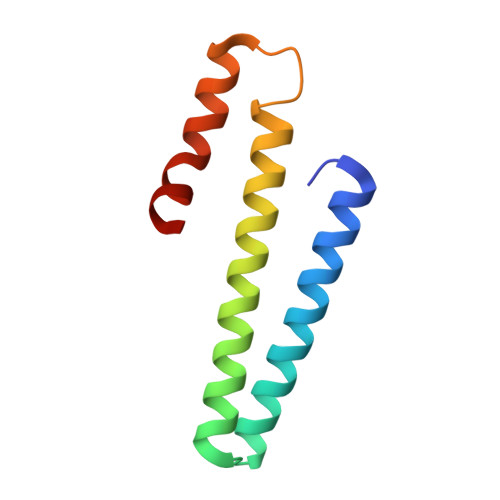The Effectors and Sensory Sites of Formaldehyde-responsive Regulator FrmR and Metal-sensing Variant.
Osman, D., Piergentili, C., Chen, J., Sayer, L.N., Uson, I., Huggins, T.G., Robinson, N.J., Pohl, E.(2016) J Biol Chem 291: 19502-19516
- PubMed: 27474740
- DOI: https://doi.org/10.1074/jbc.M116.745174
- Primary Citation of Related Structures:
5LCY - PubMed Abstract:
The DUF156 family of DNA-binding transcriptional regulators includes metal sensors that respond to cobalt and/or nickel (RcnR, InrS) or copper (CsoR) plus CstR, which responds to persulfide, and formaldehyde-responsive FrmR. Unexpectedly, the allosteric mechanism of FrmR from Salmonella enterica serovar Typhimurium is triggered by metals in vitro, and variant FrmR(E64H) gains responsiveness to Zn(II) and cobalt in vivo Here we establish that the allosteric mechanism of FrmR is triggered directly by formaldehyde in vitro Sensitivity to formaldehyde requires a cysteine (Cys(35) in FrmR) conserved in all DUF156 proteins. A crystal structure of metal- and formaldehyde-sensing FrmR(E64H) reveals that an FrmR-specific amino-terminal Pro(2) is proximal to Cys(35), and these residues form the deduced formaldehyde-sensing site. Evidence is presented that implies that residues spatially close to the conserved cysteine tune the sensitivities of DUF156 proteins above or below critical thresholds for different effectors, generating the semblance of specificity within cells. Relative to FrmR, RcnR is less responsive to formaldehyde in vitro, and RcnR does not sense formaldehyde in vivo, but reciprocal mutations FrmR(P2S) and RcnR(S2P), respectively, impair and enhance formaldehyde reactivity in vitro Formaldehyde detoxification by FrmA requires S-(hydroxymethyl)glutathione, yet glutathione inhibits formaldehyde detection by FrmR in vivo and in vitro Quantifying the number of FrmR molecules per cell and modeling formaldehyde modification as a function of [formaldehyde] demonstrates that FrmR reactivity is optimized such that FrmR is modified and frmRA is derepressed at lower [formaldehyde] than required to generate S-(hydroxymethyl)glutathione. Expression of FrmA is thereby coordinated with the accumulation of its substrate.
Organizational Affiliation:
From the Department of Chemistry, School of Biological and Biomedical Sciences, Durham University, Durham DH1 3LE, United Kingdom.














